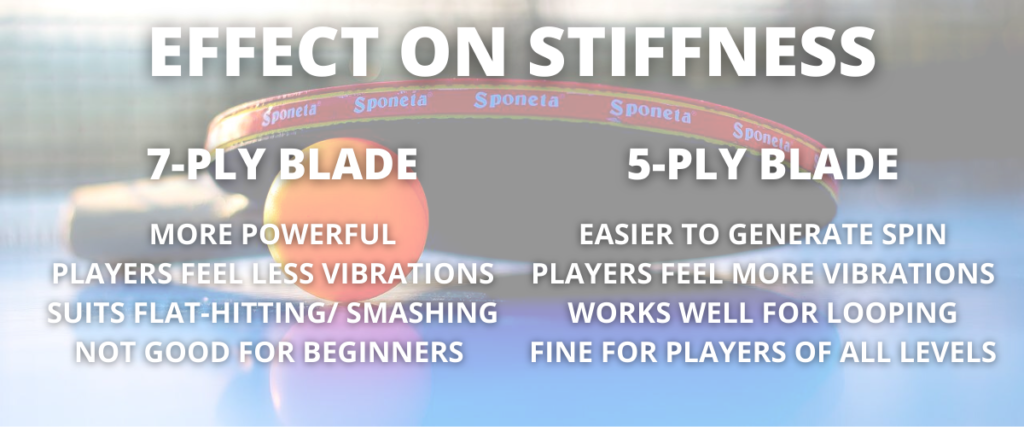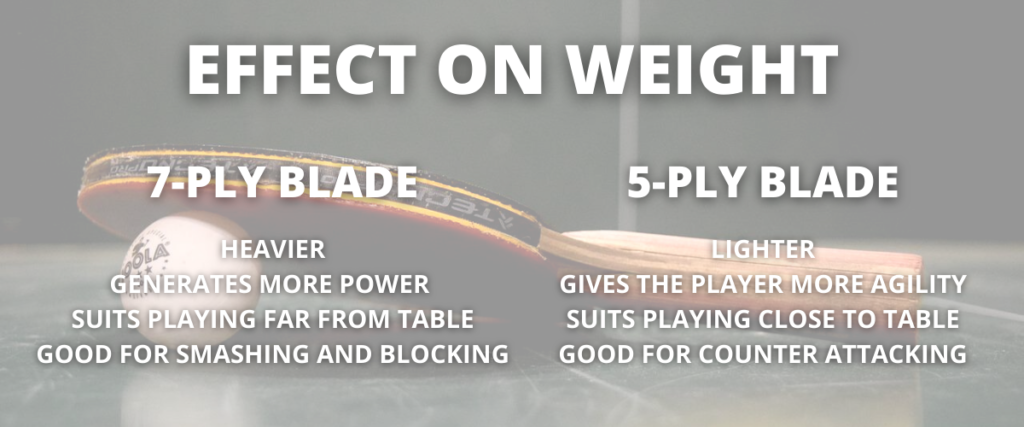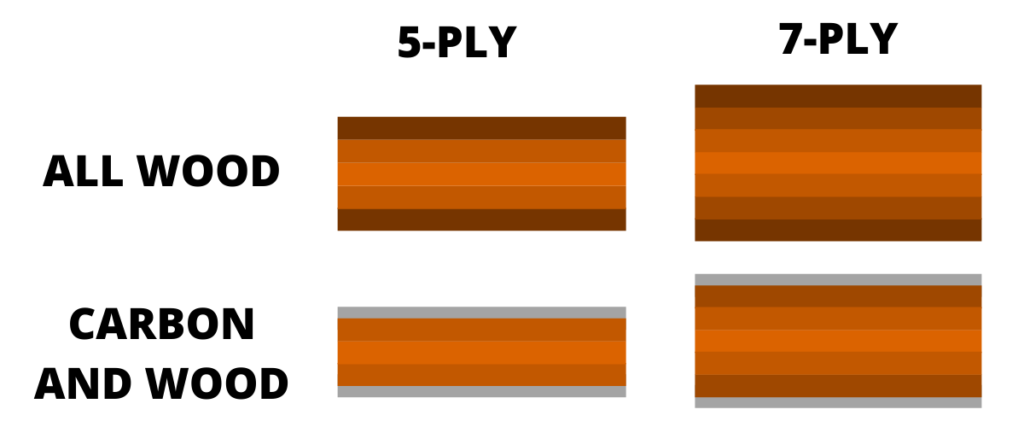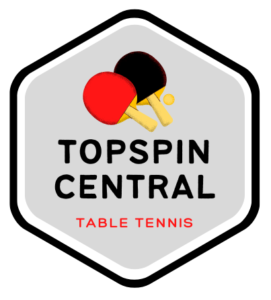There are many different types of table tennis blades on the market and one of the ways to categorise them is by the number of layers, the most common being 5 and 7. But how many layers is best? In this article, I’ll compare the differences between 5-ply and 7-ply blades so you can figure out which is the best choice for you.
5-Ply vs 7-Ply Blades
A 5-ply blade will be more flexible and lighter than a 7-ply blade if the layers have the same thickness and the same materials are used. A 5-ply blade will vibrate more in the players hand, make it easier to generate spin and give the player more agility. However, a 7-ply blade is more powerful.
| 5-Ply Blade | 7-Ply Blade |
| More flexible and lighter | Stiffer and heavier |
| Easiest to generate more spin | Generates more power |
| Good for all-round, counter-attacking and defensive styles | Good for fast-attackers and offensive styles of play |
Table Tennis Blade Composition
A table tennis blade is made up of multiple layers glued together. Typically, the blade will either have 5-layers or 7-layers and will be referred to as either a 5-ply or a 7-ply blade.
These layers can be made from different types of wood or carbon, and vary in thickness and density. This gives the blade a different feel and affects how it performs.

There are a few variables to consider here when discussing the composition of the blade:
- Number of layers (plies)
- Type of material used in each layer and it’s density
- Thickness of each layer
To keep things simple, I will just be discussing variable #1 (number of layers) in isolation in the next sections of the article. Hence, we will be assuming that the type of the material and the thickness of each layer stays the same.
In reality, this is not always the case so I will be discussing the other variables such as carbon vs wood later in the article.
Why Does the Number of Layers Matter?
The number of layers used to make the blade affects two main physical characteristics:
- Stiffness
- Weight
Effect on Stiffness
A 7-ply blade will be thicker than a 5-ply blade, assuming the same materials are used and the thickness of each layer is consistent. Hence, a 7-ply blade will be stiffer than a 5-ply blade. The stiffness of the blade impacts how the blade feels and how much spin and power it is capable of generating.
- 5-ply blades are thinner and more flexible meaning that the player will feel the vibrations when the hitting the ball compared to with a 7-ply blade. These vibrations are useful when learning a new technique as they give the player more feedback so they can feel what good/ bad strokes feel like.
- 5-ply blades have more flex which helps them generate more spin compared to 7-ply blades which feel more rigid.
- 7-ply blades are more powerful than 5-ply blades. This means that the ball will move faster after being struck with the paddle when hit with a 7-ply blade compared to a 5-ply blade which would require more effort from the player to generate as much force on the ball.
A 5-ply blade is often recommended for beginners because it provides more feedback in the way of vibrations, allowing them to actually improve faster. That’s not to say that 5-ply blades are only for beginners though. Advanced players can still use 5-ply blades, it’s just a matter of personal preference as to whether the player wants to feel these vibrations.
Since 7-ply blades are more powerful, they are often favoured for flat-hitting, smashing and blocking. A 5-ply blade is great for looping as it allows the player to generate a lot of spin more easily.
Remember though, the number of plies is just one variable to consider here. That’s why many pros use 7-ply blades and can generate a tonne of spin. It’s because there’s a lot more going on to consider with the blade than just the number of layers.

Effect on Weight
Assuming the layers are the same thickness and the same material is used, a 5-ply blade will be lighter compared to a 7-ply blade. The weight of the blade has an impact on two things:
- Agility
- Power
Lighter blades allow the player to be more agile because they can move the paddle faster and react more quickly to incoming shots. This is great for counter-attacking and players who stand close to the table.
Heavier blades allow the player to generate more power. In other words, if the player uses the same effort for the stroke, the ball will travel faster when struck with the paddle when using the heavier blade compared to the lighter blade. This is useful for smashing, blocking and driving.

As mentioned earlier, the thickness of each layer and the material used will also have an effect on the weight. Hence, this effect only really comes into play when considering blades made from the same material e.g. all-wood blades.
Check out my comparison between heavy and light blades for more info.
Does the Number of Layers Affect Hardness?
The hardness of a table tennis blade is not the same as the stiffness. The stiffness is affected by the overall composition of the blade and how thick it is. However, the hardness of the blade refers to the characteristics of the outer two layers of the blade.
Hence, hardness is not really affected by the number of layers of the blade.
Types of Blade and Playing Style Suitability
Okay so here’s where things can get more complicated. Up until now we’ve only discussed one variable, the number of plies. Now let’s look at how the material also affects the blade’s characteristics.
There are 4 main types of blades. Two of the types are 5-ply blades and two of the type are 7-ply blades. Blades of the same ply are distinguished by the material used, be that either carbon or wood.
- 5-Ply All-Wood
- 7-Ply All-Wood
- 5-Ply Carbon and Wood
- 7-Ply Carbon and Wood
In the case of 5-ply and 7-ply carbon and wood blades, you’ll often hear them being referred to as 3+2 or 5+2 blades. The “3” or “5” refers to the number of wood layers, and the “+2” indicates the two carbon layers

Now let’s take a look at each type of 5-ply and 7-ply blade and consider their characteristics. Here we will be assessing:
- Hardness
- Stiffness
- Weight
Again, to keep things more simple, we will not be directly considering the thickness of each layer as a variable.
Assume that the differences we are discussing are due to only two variables: number of plies and the type of material (carbon or wood).
There are also different types of carbon and wood which have different properties to further complicate things, so we won’t be delving into that here. Assume that the same type of wood and carbon, and the thickness of each layer is being used.
The number of plies affects the stiffness of the blade primarily. The material affects the hardness of the blade instead. Carbon is harder than wood, which means it will generate more power and feel more direct, but will make it harder to generate spin for beginners since a fuller stroke is required.
5-Ply All-Wood
Wood is softer and more flexible than carbon, and you’ll remember that 5-ply blades are also more flexible than 7-ply blades. Hence an all-wood 5-ply blade will be:
- Soft
- Flexible
- Good for generating spin and looping
- Give the player plenty of feedback
- Not very powerful
- Good for beginners
7-Ply All-Wood
- Soft
- Stiff
- Moderately powerful
- Moderately good for spin
- Will not vibrate much
- Okay for beginners
3+2 Ply Carbon and Wood
- Stiff
- Flexible
- Moderately powerful
- Moderately good for spin
- Will the player considerable feedback (vibrations)
- Not good for beginners
5+2 Ply Carbon and Wood
- Stiff
- Hard
- Very powerful
- Harder to generate spin and control
- Will not vibrate much
- Very unsuitable for beginners
Here are some more articles you might find useful:
